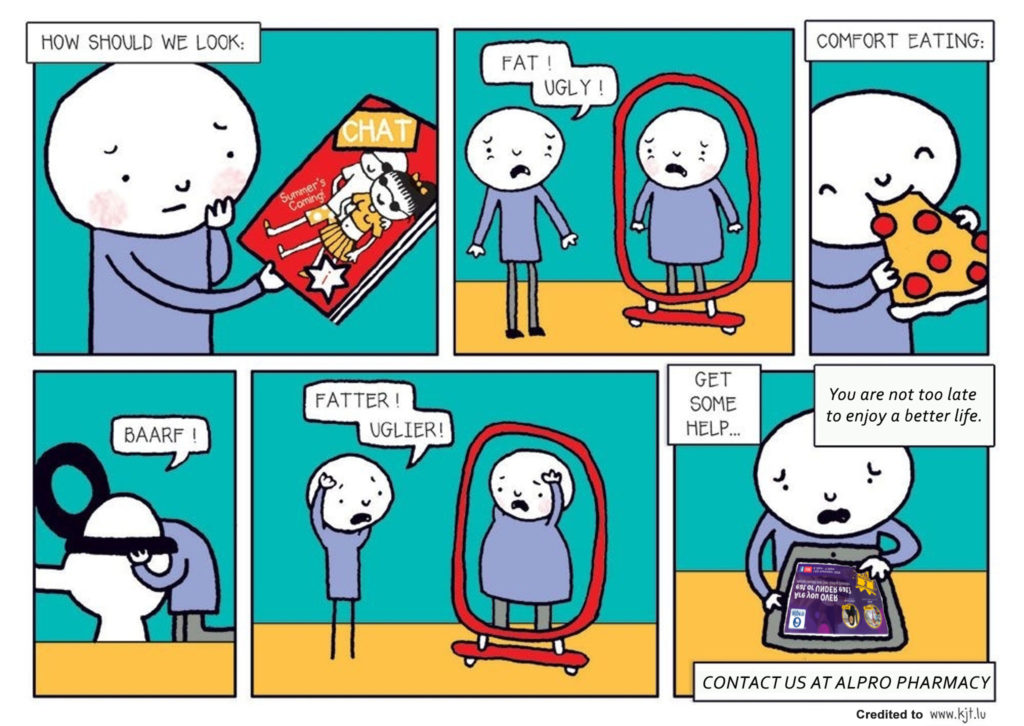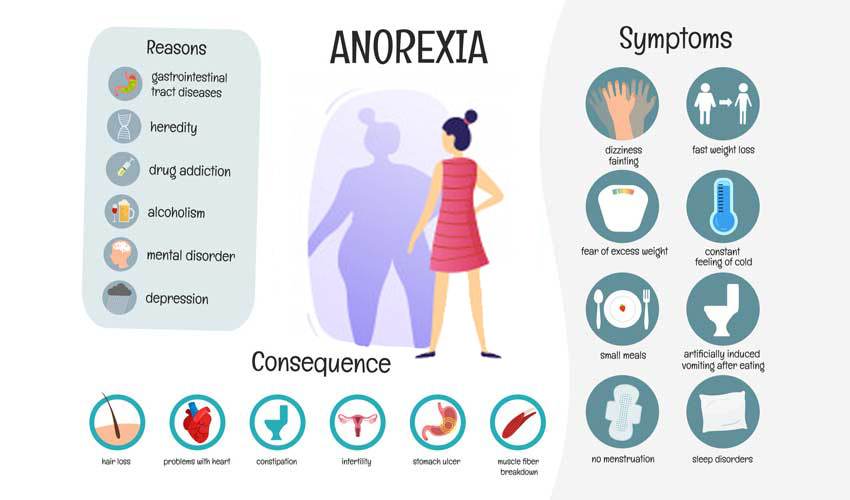Eating disorders are eating behaviours that endangers an individual’s physical and psychosocial health.

Eating disorders include :
- Anorexia Nervosa :
Characteristics :
- Refusal to maintain normal body weight for age and height, leading body weight less than 85% of expected weight.
- Having excessive fear of gaining weight even though the individual is currently underweight.
- Body image distortion and denial of the seriousness of having current low body weight.
- Subtypes of anorexia nervosa are :
- Diet restriction. They purposely limit food intake and refuse to maintain body weight at a healthy range for their height and age.
- Binge eating/purging. Eat-in large amounts (excessive calories) and being lost of control over own appetite followed by the feeling of guilty and intend to vomit out.
- Bulimia Nervosa:

Characteristics :
- Involves recurrent episodes of binge eating (eat in a discrete period of time in a large or excessive amount and accompanied by a sense of loss of control of appetite)
- Having appropriate behaviour to prevent weight gains such as self-induced vomiting, misuse of laxatives and enemas, or do the non-purging activities such as excessive exercise, increased physical activity until over the limit or excessive fasting.
- Binge Eating Disorder :
Characteristics :
- Refers to binge eating not associated with purging behaviours.
- Involves any episode of eating more rapidly than normal, eating until uncomfortable or eating when not hungry and followed by a feeling of guilt and depression.
- In some cases, weight cycling has been reported among binge eaters. This includes weight loss followed by weight gain.
Eating disorders affect primarily adolescents, most commonly young female teens.

What are the common features of eating disorders?
All such individuals generally have :
- Excessive fear of fat and a refusal of weight gain.
- Deliberately losing weight.
- Miss their periods (amenorrhea).
What are the signs and symptoms of anorexia and bulimia nervosa?
Anorexia Nervosa :
- Low pulse rate.
- Low blood pressure.
- Tiredness.
- Drowsiness.
- Dry cold skin.
- Unhealthy dry hair.
- Appearance of fine hair.
- Irritability.
- Obsessional thinking.
- Increased perfectionism.
- Social withdrawal so as to avoid situations involving eating.
- Low self-esteem.
- Loss of period.
Bulimia Nervosa :
- Swollen salivary glands from recurrent vomiting.
- Irregular menstruation caused by energy deficiency during periods of starvation.
- Dental decay caused by the high acid content of vomitus.
- Abdominal pain due to acute stretching or dilatation of the stomach due to overeating.
- Irritable bowel, dark mucous in the colon, disturbed bowel motion from chronic laxative use.
- Difficulty in sleeping.
- Chronic hoarseness of voice.
What are the consequences associated with eating disorders?
Serious complications may arise.
They are :
- Nutritional disturbances of depending on the severity and duration of dysfunctional dietary habits. Abnormalities include :
- Loss of muscle mass, body fat, and bone mineral.
- Deficiencies of minerals, vitamins, and trace elements.
- Psycho-social disturbances :
- Adjustment problems with puberty.
- Social isolation and family conflicts.
- Low self-concept, self-esteem, and poor romantic involvement.
- Mental disorders like anxiety and depression.
- Problems with :
- Growth retardation and delay during puberty.
- Bone mass leading to osteoporosis.
- Medical complications leading to death.
How can you be helped?
- Talk to your parents/family members/teachers/friends and seek medical help.
- Physical and occupational therapies are also useful.
- Consult your doctor. Hospitalisation is necessary for the presence of malnutrition and
What does treatment involve?
- Generally involves medical and nutrition/dietary management.
- Treatment is usually a slow, difficult and challenging process.
- A conducive health care environment and family supports are essential.
- Hospitalisation is required in severe cases.
Dietary treatment
The objective of nutrition intake:
- To correct signs and symptoms of malnutrition.
- To promote a healthy weight gain. Obtain nutritional assessment through diet history to identify appropriate calories, micro and macronutrients and fluids.
- To provide nutrition education and counseling care plan accordingly.
Dietary recommendations :
- Encourage oral intake of small and frequent meals that are attractive, palatable and varied. Six to eight meals per day are suggested. Tube feeding is necessary if not tolerating orally well.
- High calories are needed but to be increased slowly. Start with low calories at a minimum of 1000 kcal/day up to 1600 kcal/day.
- Maximum calories of 40-60 kcal/kg body weight are reported for some cases. Increase calories only if tolerated with the current diet regime and weight gain improved.
- Do not force feed. Help to resume normal eating habits. Limit certain foods to avoid further deterioration. Limit salt intake to reduce fluid retention and avoid caffeine due to its diuretic effect.
- Encourage macronutrients as in carbohydrate, protein, and fat intakes in minimum range to achieve weight gain goal. Use a high biological value of protein sources, insoluble fiber and essential fatty acids within the normal range of recommendations.
- Some vitamin-mineral supplements may necessary as suggested by the doctor or dietitian.
- Counseling and nutrition education is quite challenging since in most cases people with an eating disorder has high knowledge in nutrition care. Individual counseling is needed together with several follow-up sessions in helping them to maintain a good, healthy diet and habits.
- May include family members in diet/nutrition counseling as supporters and to avoid conflict and reject emotions.

References:
- Escott-Stump. S (2002) Nutrition and Diagnosis-Related Care. Fifths Edition. Lippincott Williams &Wilkins, USA.
- Mahan LK, Escott-Stump S (2004) Krause’s Food, Nutrition & Diet Therapy. 11th edition. Elsevier USA.
- Malaysian Association for the study on Obesity (2005) Strategy for the Prevention of Obesity- Malaysia: Malaysian Association for the Study of Obesity.
- National Coordinating Committee on Food & Nutrition. MOH. ( 2005). Recommended Nutrient Intakes for Malaysia: Ministry of Health Malaysia.
- Nutrition Society Malaysia (2002). Resipi Sihat,Pilihan Bijak: Kementerian Kesihatan Malaysia
- Credited to: http://www.myhealth.gov.my/en/eating-disorders/



